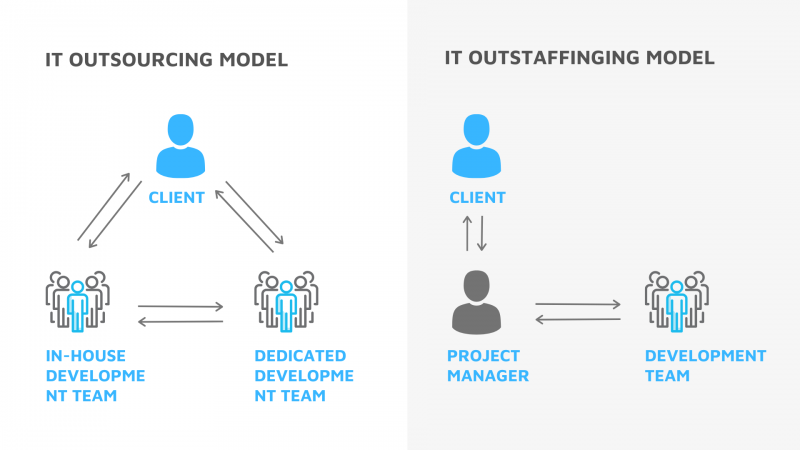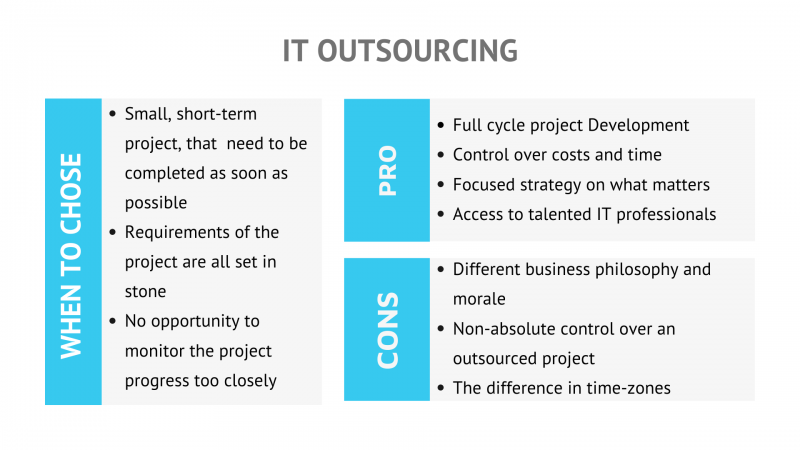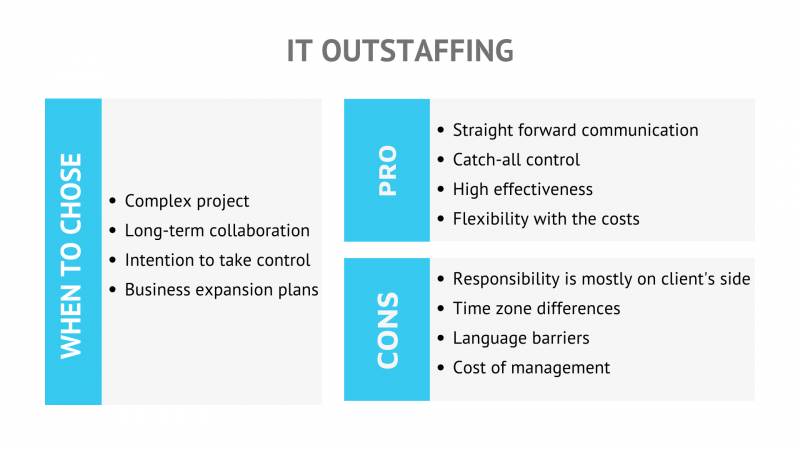Digital transformations require qualified staff. The traditional approach is to build an in-house team of software developers. However, it is not easy to find and get the professionals you need. And if you really need it? Remote employment – IT outsourcing or IT outstaffing tech pros – seems like the solution for every geographically-independent business.
It’s safe to say that this was the COVID-19 pandemic that drove businesses to adopt the remote work mode en masse. However, remote working has already become the new normal and is likely to stay here for good.
Contents
- 1 WHY IS HIRING REMOTE SOFTWARE DEVELOPMENT TEAMS SUCH A POPULAR CHOICE?
- 2 WHAT IS IT OUTSOURCING?
- 3 WHAT IS IT OUTSTAFFING?
- 4 DEDICATED DEVELOPMENT TEAM IN OUTSTAFFING: ABLE TO DO EVERYTHING
- 5 OUTSOURCING VS. OUTSTAFFING: WHAT TO CHOOSE?
- 6 OUTSOURCING AND OUTSTAFFING WITH DEVCOM
- 7 OUTSOURCING VS. OUTSTAFFING FAQ:
Still, before you rush to look for your perfect outsourcing team, it’s vital to decide on the outsourcing model that can best meet your business needs. Stay with us to read about the key differences between outsourcing and outstaffing, and even more.
WHY IS HIRING REMOTE SOFTWARE DEVELOPMENT TEAMS SUCH A POPULAR CHOICE?
Remote development is a great opportunity for any company to improve its business process and reap the benefits over the medium to long term. Now is the time to prepare for this ‘new normal’. Think of less office space, less commuting, an optimized number of employees, and lower expenses.
Both software outsourcing and outstaffing will more than ever become an integral part of the way global business works. So why should an employer pay a New York salary if it is possible to pay the Ukrainian wage and get the job done with the same results? Business leaders should already think about the potential of investing in remote development that will have far-reaching consequences on the way we work in the future.
Key findings from the IT Outsourcing Study
- 74% of European organizations are planning to outsource at the same rate.
- 89% of European organizations are satisfied with their IT service provider(s).
Business benefits of having a remote development team
- First of all, and what really matters – companies can significantly reduce costs they spend on infrastructure and salaries by IT outsourcing/ IT outstaffing.
- The overhead costs associated with occupying corporate real estate such as rents, mortgages, and security deposits are virtually non-existent.
- The remote model allows tapping into the global pool of talent.
- Hiring an offshore development team often means getting access to the newest programming languages and technologies.
- Remote teams are incredibly motivated and encouraged to work hard to maintain flexibility.
- Availability around the clock (e.g. DevOps).
- High quality of the end-product delivery.
- Freeing your in-house employees for other purposes.
- You can outsource/outstaff anything that requires expertise your company doesn’t have.
The most frequently outsourced IT services
The major sectors for IT outsourcing / outstaffing are IT and Communication, Medical and Health Services, Finance, Logistics and Transportation, Entertainment, eCommerce, and Retail

While IT outsourcing and outstaffing are often considered to be the same, there is a significant difference. Let’s look closer at the three most popular software development models.
WHAT IS IT OUTSOURCING?
Before we dive deeper into the outsourcing vs. outstaffing vs. dedicated team topic, let’s make sure that we’re on the same page and get clear with the term ‘outsourcing’.
Software development outsourcing mainly describes a situation in which an organization chooses to hire a third-party vendor to handle the software development process from the ground and up. The only things an organization should provide is the project idea, requirements, and budget.
While in-house development requires paying regular salaries, providing workspaces, and procurement, outsourcing becomes a cost-effective solution. Not to mention, software outsourcing can be a great advantage for startups. It can help them grow their business by allowing them to focus more on operations and business development rather than worrying about the software.
Depending on the location of the outsourced team, there are several types of IT outsourcing:
- Moving business/ software development overseas – results in lower costs because of the more favorable economic situation.
- Onshore – remote work with teams that reside in the same home country as the client partner.
- Offshoring – having the outsourced business functions done in another country. Offshore software development companies operate virtually and remotely.
- Nearshoring – working with teams in a similar time zone, close-border country. Nearshore software development companies delegate operations to teams abroad.
- Homeshoring – remote employees (freelancers) working from home.
IT outsourcing pros and cons
Pros
Software outsourcing is a cost-effective solution, and this is its most obvious advantage. It takes a vast bulk of the work off your hands, as the outsourcing company will handle the full-cycle development of your project. They will form the development team, carry out project management, and implement quality control.
Cons
If you delegate some of your business tasks or processes to an external service provider, you may face some shortcomings like different business philosophies and morale, non-absolute control over an outsourced project, and difference in time zones. The outsourcing development model requires that you define the full specifications of your project at the beginning. Still, with extra services such as project management, business analysis, and quality assurance, you can have some unpredictable expenses. It can also delay project completion.
Project-based outsourcing is recommended for companies that:
- have a small, short-term project with clear requirements set in stone;
- can’t control the project progress directly.

WHAT IS IT OUTSTAFFING?
Software outstaffing, or staff augmentation model, is an extension of the in-house development team as if they were a team next door. In IT outstaffing, you hire individuals from outside your organization to do the work under your monitoring. Most of the time, businesses follow this structure to hire faster and more effective workers outside their territory.
IT outstaffing fits startups and enterprises that already have an in-house development team but at the same time need extra resources (developers, designers, QAs, DevOps, architects, etc.) to complete tasks they can’t handle themselves. This business model suggests that the provider is responsible for people management, low-level tasks, and process quality.
In most cases, the outstaff team works together with the in-house programmers. The client can control remote programmers’ workflow and productivity and give them tasks. By performing work under the outstaffing contract, employees are subject to the customer’s employment schedule and usually perform their jobs in the customer’s premises and job descriptions.
There are several types of IT outstaffing:
- Leasing staff – long term projects for a period of more than three months.
- Temporary staffing – a temporary project of 1 week to 3 months periods.
IT outstaffing pros and cons
Pros
Hiring dedicated developers gives you full control over the project. It also provides you with greater financial flexibility. It does not require you to define the complete set of project requirements at the beginning; you can adjust the size of your outstaffed team as your needs change.
Cons
Outstaffing requires constant communication and collaboration with your offshore team, so when hiring from a distant country, time differences and language barriers may pose challenges.
The outstaffing model is recommended for clients who:
- have a large or long-term project they want to work on;
- seek to close skill and technical expertise gaps within their internal team;
- prefer to control the project’s progress directly;
- need flexibility in changing project requirements and extending their development team

DEDICATED DEVELOPMENT TEAM IN OUTSTAFFING: ABLE TO DO EVERYTHING
The term “dedicated development” really refers to a development team model. When having an in-house development team isn’t feasible, hiring a dedicated team of developers from outside the company is the next best option.
This is a widespread practice in the IT industry to reduce costs and risks associated with increasing the number of employees. With the dedicated team model, you hire remote developers who will dedicate 100% of their time to your project but remain in the dedicated team provider’s office. They may form the company’s entire development team, or they may collaborate with your in-house developers. Each dedicated specialist is selected specifically for the client’s project and is not engaged in any other projects.
This model is a type of IT staff augmentation or IT outstaffing.
When do you need the services of a dedicated development team?
- When it is a long term project that needs continuous updates and improvements.
- When the scope changes and technical requirements are unclear.
- When internal developers have no time to carry out the project or have no required expertise in specific areas.
- When the company is on a tight budget and is not cost-effective paying high local salaries.
- When the company doesn’t want to waste time on employee hiring and personnel management.
- When the project needs to be scaled on time.
Dedicated development pros and cons
Pros
Hiring a dedicated team of software engineers can be a huge benefit for the business. It allows saving on software development costs and time to market for their product while enjoying the full transparency of the development process and real-time communication. The client company has complete control over the project delivery and teamwork, engagement with business needs, flexibility for planning, and priority changes. The cost is entirely predictable. There is an opportunity to grow or decrease projects when it’s necessary.
Cons
This offshore development model is associated with the following disadvantages: the customer is responsible for all the risks, it doesn’t work for short-term projects, and the hiring process (assembling the right team) can take some time (2-3 weeks).
Related Post: Dedicated Development Team: a Winning Approach to Outsourcing
OUTSOURCING VS. OUTSTAFFING: WHAT TO CHOOSE?
Sometimes it can be challenging for a company to weigh its IT project options while both outsourcing and outstaffing have their pros and cons. In fact, there is no winner in the outsource vs outstaff battle — your choice should depend exclusively on your unique needs and business goals.
If you have enough work to keep the external team occupied on a long-term basis and it’s crucial for you to stay in full control over the project, hiring an outstaffing team might be your way to go.
Still, sometimes partnering with an outsource team is a wiser solution. For instance, it’s a better option if you have occasional IT needs such as building a new app.
OUTSOURCING AND OUTSTAFFING WITH DEVCOM
Finding a reliable partner can help you gain substantial competitive advantages both in the context of short-term and long-term strategies.
So now, based on this fuller outsourcing vs outstaffing picture, you can make a thoughtful decision on choosing a trusted offshore development partner for your project.
If you are still struggling with the challenges of choosing a remote development vendor, we at DevCom will do our best to turn up with the most reasonable IT outsourcing or outstaffing solution for your business requirements.
DevCom has 20 years of experience in remote work and management of remote teams based in Ukraine for clients in the USA, Canada, the UK, Western Europe, Australia, and the Middle East under outsourcing and outstaffing models. We know exactly how to ensure your business can continue to function optimally.
Explore how we work and deliver Agile software development teams, or drop us a line, and we’ll be more than glad to discuss your project.




